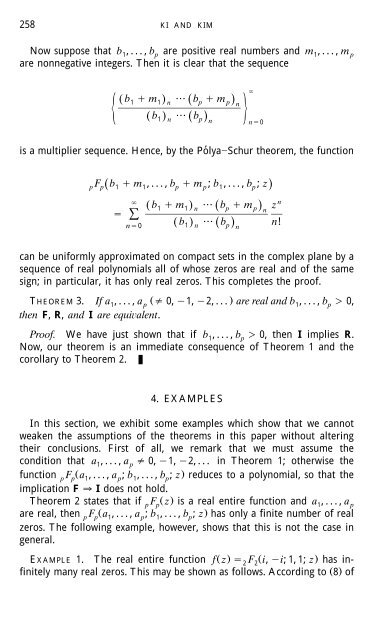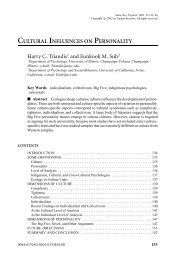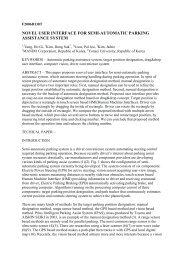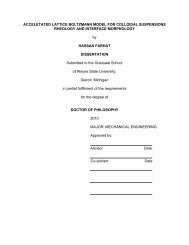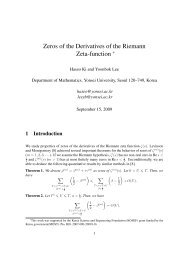On the Zeros of Some Generalized Hypergeometric Functions
On the Zeros of Some Generalized Hypergeometric Functions
On the Zeros of Some Generalized Hypergeometric Functions
You also want an ePaper? Increase the reach of your titles
YUMPU automatically turns print PDFs into web optimized ePapers that Google loves.
258<br />
KI AND KIM<br />
Now suppose that b ,...,b are positive real numbers and m ,...,m<br />
1 p 1 p<br />
are nonnegative integers. Then it is clear that <strong>the</strong> sequence<br />
½ Ž b1m1. n Ž bpmp. 5 n<br />
Ž b . Ž b .<br />
1 n p n n0<br />
is a multiplier sequence. Hence, by <strong>the</strong> PolyaSchur ´ <strong>the</strong>orem, <strong>the</strong> function<br />
pFpŽ b1m 1,...,bpm p; b 1,...,b p;<br />
z.<br />
<br />
Ý<br />
Ž 1 1. Ž p p.<br />
Ž . Ž .<br />
b m b m z<br />
<br />
n n<br />
b b n!<br />
n0 1 n p n<br />
can be uniformly approximated on compact sets in <strong>the</strong> complex plane by a<br />
sequence <strong>of</strong> real polynomials all <strong>of</strong> whose zeros are real and <strong>of</strong> <strong>the</strong> same<br />
sign; in particular, it has only real zeros. This completes <strong>the</strong> pro<strong>of</strong>.<br />
THEOREM 3. If a ,...,a Ž 0, 1, 2, . . . .<br />
1 p are real and b 1,...,bp 0,<br />
<strong>the</strong>n F, R, and I are equialent.<br />
Pro<strong>of</strong>. We have just shown that if b ,...,b 0, <strong>the</strong>n I implies R.<br />
1 p<br />
Now, our <strong>the</strong>orem is an immediate consequence <strong>of</strong> Theorem 1 and <strong>the</strong><br />
corollary to Theorem 2.<br />
4. EXAMPLES<br />
In this section, we exhibit some examples which show that we cannot<br />
weaken <strong>the</strong> assumptions <strong>of</strong> <strong>the</strong> <strong>the</strong>orems in this paper without altering<br />
<strong>the</strong>ir conclusions. First <strong>of</strong> all, we remark that we must assume <strong>the</strong><br />
condition that a 1,...,a p 0, 1, 2, . . . in Theorem 1; o<strong>the</strong>rwise <strong>the</strong><br />
function F Ž a ,...,a ; b ,...,b ; z. p p 1 p 1 p reduces to a polynomial, so that <strong>the</strong><br />
implication F I does not hold.<br />
Theorem 2 states that if F Ž z. p p is a real entire function and a 1,...,a p<br />
are real, <strong>the</strong>n F Ž a ,...,a ; b ,...,b ; z. p p 1 p 1 p has only a finite number <strong>of</strong> real<br />
zeros. The following example, however, shows that this is not <strong>the</strong> case in<br />
general.<br />
Ž . Ž .<br />
EXAMPLE 1. The real entire function f z F i, i;1,1; z has in-<br />
2 2<br />
Ž.<br />
finitely many real zeros. This may be shown as follows. According to 8 <strong>of</strong><br />
n


